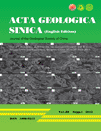Coexistence of Hyperpycnites, Debrites and Turbidites and Their Geological Significances of Unconventional Petroleum
Corresponding Author
Renchao YANG
College of Earth Science and Engineering, Shandong University of Science and Technology, Qingdao 266590 China
Corresponding author. E-mail: [email protected]Search for more papers by this authorZhijun JIN
Petroleum Exploration and Production Research Institute, SINOPEC, Beijing 100083 China
Search for more papers by this authorDongsheng SUN
Petroleum Exploration and Production Research Institute, SINOPEC, Beijing 100083 China
Search for more papers by this authorZuozhen HAN
College of Earth Science and Engineering, Shandong University of Science and Technology, Qingdao 266590 China
Search for more papers by this authorAiping FAN
College of Earth Science and Engineering, Shandong University of Science and Technology, Qingdao 266590 China
Search for more papers by this authorCorresponding Author
Renchao YANG
College of Earth Science and Engineering, Shandong University of Science and Technology, Qingdao 266590 China
Corresponding author. E-mail: [email protected]Search for more papers by this authorZhijun JIN
Petroleum Exploration and Production Research Institute, SINOPEC, Beijing 100083 China
Search for more papers by this authorDongsheng SUN
Petroleum Exploration and Production Research Institute, SINOPEC, Beijing 100083 China
Search for more papers by this authorZuozhen HAN
College of Earth Science and Engineering, Shandong University of Science and Technology, Qingdao 266590 China
Search for more papers by this authorAiping FAN
College of Earth Science and Engineering, Shandong University of Science and Technology, Qingdao 266590 China
Search for more papers by this author
References
- Clare, M.A., Talling, P.J., Challenor, P., Malgesini, G., and Hunt, J., 2014. Distal turbidites reveal a common distribution for large (>0.1 km3) submarine landslide recurrence. Geology, 42: 263–266
- Etienne S, Moulder T, Bez M, et al. Multiple scale characterization of sand-rich distal lobe deposit variability: Examples from the Annot Sandstones Formation, Eocene-Oligocene, SE France. Sedimentary Geology, 2012, 273–274: 1–18.
- Lamb, M.P. and Mohrig, D., 2009. Do hyperpycnal-flow deposits record river-flood dynamics? Geology, 37: 1067–1070
- Mulder T, Syvitski J P M. Turbidity currents generated at river mouths during exceptional discharges to the world oceans. The Journal of Geology, 1995, 103(3): 285–299.
- Sawyer, D.E., Flemings, P.B., and Nikolinakou, M., 2014. Continuous deep-seated slope failure recycles sediments and limits levee height in submarine channels. Geology, 42: 15–18.
- Shanmugam G. 1996. High-density turbidity currents: Are they sandy debris flows? Journal of Sedimentary Research, 66: 2–10.
- Sumner, E.J., Siti, M.I., McNeill, L.C., Talling, P.J., Henstock, T. J., Wynn, R.B., Djajadihardja, Y.S., and Permana, H., 2013. Can turbidites be used to reconstruct a paleoearthquake record for the central Sumatran margin? Geology, 41: 763–766
- Talling, P. J., Masson, D. G., and Sumner, E. J., 2012. Subaqueous sediment density flows: depositional processes and deposit types. Sedimentology, 59: 1937–2003.
- Yang Renchao, He Zhiliang, Qiu Guiqiang, Jin Zhijun, Sun Dongsheng, Jin Xiaohui. 2014. A Late Triassic gravity flow depositional system in the southern Ordos Basin. Petroleum Exploration and Development, 41(6): 724–733.
- Yao, Y., Flemings, P., and Mohrig, D., 2012. Dynamics of dilative slope failure. Geology, 40: 663–666.




